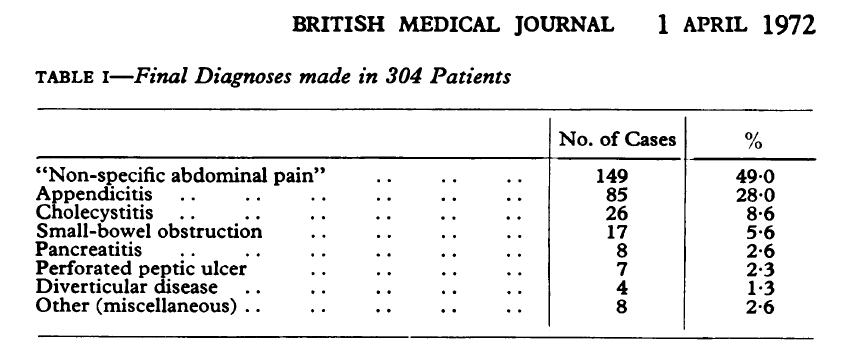Computer-aided diagnosis of acute abdominal pain
- De Dombal, F. T., Leaper, D. J., Staniland, J. R., McCann, A. P., & Horrocks, J. C.
- British Medical Journal, 2, 9-13
- An online version of the paper can be found here
- Want a summary of academic papers with alpha? Check out our free Academic Alpha Database!
Abstract:
This paper reports a controlled prospective unselected real-time comparison of human and computer-aided diagnosis in a series of 304 patients suffering from abdominal pain of acute onset. The computing system’s overall diagnostic accuracy (91·8%) was significantly higher than that of the most senior member of the clinical team to see each case (79·6%). It is suggested as a result of these studies that the provision of such a system to aid the clinician is both feasible in a real-time clinical setting, and likely to be of practical value, albeit in a small percentage of cases.
Prediction:
The authors examine patients with acute abdnominal pain admitted into the professorial surgical unit in the General Infirmary at Leeds.
Here is how the test works
- Tabulate diagnosis from the clinical team, the house surgeon’s diagnosis, and any senior members of the team who saw the patient. (“human” estimates and analysis)
- Case history were entered into a computing system to produce a real-time diagnosis.
- Compare diagnosis across humans and the computer.
Here are the categories considered (many of which are abbreviated in subsequent tables):
Alpha Highlight:
First, a look at how the computer stacks up against the “experts,” aka, the senior clinician to the see the case:
Ouch. Computers trounce the top brains.
Thoughts on the paper?
About the Author: Wesley Gray, PhD
—
Important Disclosures
For informational and educational purposes only and should not be construed as specific investment, accounting, legal, or tax advice. Certain information is deemed to be reliable, but its accuracy and completeness cannot be guaranteed. Third party information may become outdated or otherwise superseded without notice. Neither the Securities and Exchange Commission (SEC) nor any other federal or state agency has approved, determined the accuracy, or confirmed the adequacy of this article.
The views and opinions expressed herein are those of the author and do not necessarily reflect the views of Alpha Architect, its affiliates or its employees. Our full disclosures are available here. Definitions of common statistics used in our analysis are available here (towards the bottom).
Join thousands of other readers and subscribe to our blog.



